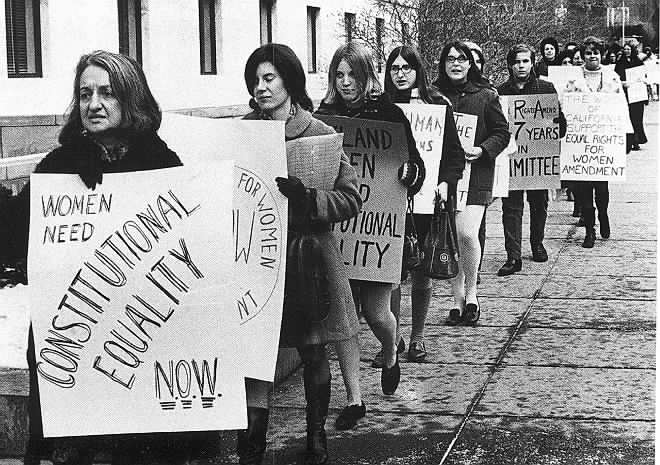Jordan Adorno
12 April 2010
Extra Credit Paper
Mondays-Wednesdays 2:00-3:15
"Second-Wave Feminism: the Impact of two Unconventional Publications"
Second-Wave Feminism was a rich and fervent movement for women’s rights that peaked in the 1960s. It fought to instill a message that men and women are equal, and that women are entitled to equal rights as opposed to the excessively degraded, constrictive options of the time. Coloring the forefront of the movement were two highly influential feminists: first, Gloria Steinem, editor-in-chief of Ms. Magazine and the leader of the campaign for the Equal Rights Amendment, who wrote the daring “I was a Playboy Bunny”; second, Betty Freidan, the polarizing author of the controversial book The Feminine Mystique, which was a rigorous attack on what she considered to be the typical poor perception of women as 'inferior' across America. These two particular feminists famously combated the messages of antifeminists that endorsed the highly penetrative messages in articles like the “Good Wife's Guide” in the inflammatory 1950s magazine Good Housekeeping, which instructed women on how to be perfectly subservient to their husbands. Regardless of individual opinions, however, the works of Gloria Steinem and Betty Freidan sent a message to women everywhere to equalize themselves in society – one that managed to pull past the borderlines of antifeminism and beyond.
In order to begin, the question of why any elementarily educated American can tell you who Martin Luther King Jr. is, while perhaps only half could tell you who Gloria Steinem is must be postulated; hence, why is the average eighteen-year-old American likeliest to be minutely knowledgeable about Second-Wave Feminism while well-informed, in an ironic contrast of likelihood, about Black America's civil movement? There is no questioning either extraordinary monument; both were catalysts to unarguable, superior advancements of civil rights in America's history. Respective, the movements - exceeding beyond (as required) the far edge of reasonable doubt in level of importance - prove ultimate to any ADEQUATE history curriculum. Both, needless to say, deserve rightful-honored remembrances.
The most obvious answer as to the cause of "educator's bias", thus, is perilous - stigma. Because when Americans think of 'feminism' it's highly common that they think of inflammatory meanings which, usually erroneous, are fast-forwarded by the infamous image of radical, man-hating lesbians. Such merits little to no seriousness; complexly, it mostly requires specific education, not common knowledge, to understand accurately the sheer essence of feminism and its historic progresses: Feminism is essentially the belief that women are equal to men and deserve their respective equal rights, and the movement did not begin in the 1960s with a bunch of barbaric, rabid women burning bras like anti-propagandas so often misleadingly proliferate into the mainstream.
In actual fact, feminism spurred its First-Wave in American history during, centrally speaking, the fervent movement for women's suffrage in the late nineteenth and early twentieth centuries. Second-Wave would be the rejection of the "Good Wife" in the '50s and, far more progressively, in the heated '60s. Third-Wave is technically still current, having begun roughly in the ‘80s and ‘90s to continue the fight for equality in modern day, but many people know of no such activism. Hence, it must be first understood that the perpetual impact of antifeminist proliferations negated feminism off the map for masses of people, and “I Was a Playboy Bunny” by Gloria Steinem is one of the most exceptional hallmarks to override such reception.
Gloria Steinem is a ‘standout’ before other feminists because, essentially, she pioneered the innovative Ms. Magazine, which served as catalyst to publish her independently controversial perspectives in the mainstream. “I Was a Playboy Bunny”, specifically, remains of the most richly acclaimed due to its alternative, courageous method of inspiring female liberation: Steinem ensues her account of being an undercover Playboy bunny to expose the maltreatment degrading women in that industry first-hand, bringing a never-brought-up topic casually with blunt force. And in an America barred by housewifery and silence to such topics as Playboy, Ms. Magazine allowed Steinem unconformable means to publicize; as retrospectively summed by Serena Freewornyn from “Feminists For Choice” foundation, “In 1968, Steinem rocked the publishing world with her article “I Was a Playboy Bunny.” Gloria had gone “undercover” as a Playboy Bunny to expose Hugh Heffner for what he was. It was NOT a glamorous lifestyle” (Freewornyn par 2). Essentially, Steinem’s story drew not only attention toward the feminine labor in Playboy, but also sympathy for its female models. For once people began viewing the women with not only detest but with also pity. It effectively convoluted the glamorous undertones about the women in Playboy, taboo or not, and slammed belief that it was any sort of career worth seeking. But what's prolific about the piece was that Playboy overall symbolized a much grander message to America: women can do much greater things.
In addition to the wonders of Gloria Steinem, however, Betty Friedian’s The Feminine Mystique contended that women simply weren’t happy in a time where it was presumed that women had everything meant for them as homemakers. It rejected every notion in articles like the “Good Wife”, claiming that women were being brainwashed from an early age to forget their potentials. An excerpt from the text describes, “[Women] were taught to pity the neurotic, 'unfeminine', unhappy women who wanted to be poets or physicists or presidents.” Profound statements like this fired up both praise and resentment effectually; regardless, The Feminine Mystique broke through the glass ceiling that prevented young women from hearing motivating messages around them. Though the phenomena of women returning to school and work pays due to many feminists, Friedian’s work is credited for transcending extreme volumes because of its remarkable and unrelenting fervency.
The Feminine Mystique cleverly didn’t just complain about sexism, it provided compelling facts to illustrate the desperation of the circumstance, such as, “The proportion of women attending college in comparison with men dropping from forty-seven percent in 1920 to thirty-five percent in 1958. A century earlier, women had fought for higher education, now girls went to college to get a husband.” This particular quote's extraordinary in that it bluntly insults the backward turn society took in women’s disfavor, and it reminds society of the hard work women of the past suffered to try to make a better place for a women. It was able to taint the inaccurate orders society was giving to women by directly correcting them. Friedian clarifies powerfully, “It is no longer possible today to blame the problem on loss of femininity: to say that education and independence and equality with men have made American women unfeminine. I have heard so many women try to deny this dissatisfied voice within themselves because it does not fit the pretty picture of femininity the experts have given them.” She simply does not allow room for argument over how horrible women’s disenfranchisement from opportunities was.
Importantly, in conclusion, although in the 1950s "The Good Wife's Guide" was repugnantly like a bible for women, by the end of the 1960s controversial extraordinaires like Steinem and Friedian had successfully brought the alternative feminist perspective into mainstream lenses. Instructions to women like "Don't ask [your husband] questions about his actions or question his judgment or integrity. Remember, he is the master of the house" were beginning to mean less and less to women during Second-Wave Feminism. The same society that seemed insurmountably patriarchal had suddenly become home to an all-transcending philosophy that both Gloria Steinem and Betty Friedian centrally helped proliferate.

Updated: Friday, 20 September 2013 4:44 PM EDT
Permalink | Share This Post


